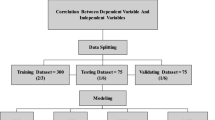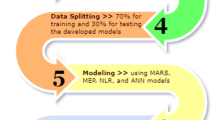Abstract
Cement kiln dust (CKD) is a fine powder similar to Portland cement in appearance and produced during grinding and burning of the raw material in the cement kiln. Large amounts of CKD have accumulated in the cement factories annually. It is necessary to re-use this waste material in the construction field instead of landfilling, causing environmental problems, such as the death of vegetation and groundwater pollution. One of the choices to re-use CKD is replacing Portland cement in cement-based mortar and reducing greenhouse gas emissions like carbon dioxide to the atmosphere. This study evaluated the effect of the main two components of CKD, such as SiO2 and CaO, on the long-term compressive strength of cement-based mortar up to 360 days of curing. For that purpose, 167 data of cement-based mortar samples modified with CKD were collected from literature and analyzed. Water-to-binder ratio (w/b) was ranged from 0.34 to 0.76, CKD content ranged from 0 to 50% (dry weight of cement), different CaO and SiO2 of CKD and cement are ranged from 17.64 to 25.45%, and 51.45 to 65.57%, respectively. Several soft computing models, such as multi-expression programming (MEP), artificial neural network (ANN), nonlinear regression (NLR), and full quadratic (FQ), were developed to predict the compressive strength of the cement mortar modified with CKD. Statistical assessment tools were also used to evaluate the proposed models. It was obtained from the modeling results that are increasing SiO2 (%) increased the compressive strength of the mortar, and increasing CaO (%) decreased compressive strength for CKD content from 0 to 15% and increasing compressive strength for CKD content of 15–50%. According to the assessment criteria, the ANN model predicted compressive strength up to 360 days of curing better than other developed models with high R2 and a20-index and low RMSE, MAE, SI, and OBJ. The second-best model was the MEP model. Based on the sensitivity analysis, the curing time is the most influential parameter in compressive strength prediction of cement-based mortar modified with CKD.



















Similar content being viewed by others
Data availability statement
The data supporting the conclusions of this article are included with the article.
References
Bhatty JI Alternative uses of cement kiln dust. 1994: Portland Cement Association.
Abdulkareem AH, Eyada SO. Production of building bricks using cement Kiln dust CKD waste. Berlin: Springer; 2018.
Peirce GJ. The possible effect of cement dust on plants. Science. 1909;30(775):652–4.
Peirce GJ. An effect of cement dust on orange trees. Plant World. 1910;13(12):283–8.
Parish SB. The effect of cement dust on citrus trees. Plant World. 1910;13(12):288–91.
Darley EF. Studies on the effect of cement-kiln dust on vegetation. J Air Pollut Control Assoc. 1966;16(3):145–50. https://doi.org/10.1080/00022470.1966.10468456.
Faraj RH, Mohammed AA, Mohammed A, et al. Systematic multiscale models to predict the compressive strength of self-compacting concretes modified with nanosilica at different curing ages. Eng Comput. 2021. https://doi.org/10.1007/s00366-021-01385-9.
Mohammed AS. Effect of temperature on the rheological properties with shear stress limit of iron oxide nanoparticle modified bentonite drilling muds. Egypt J Pet. 2017;26(3):791–802. https://doi.org/10.1016/j.ejpe.2016.10.018.
Mohammed A, Mahmood W. Statistical variations and new correlation models to predict the mechanical behavior and ultimate shear strength of gypsum rock. Open Eng. 2018;8(1):213–26. https://doi.org/10.1515/eng-2018-0026.
Mohammed A, Mahmood W. Vipulanandan failure models to predict the tensile strength, compressive modulus, fracture toughness and ultimate shear strength of calcium rocks. Int J Geotech Eng. 2018. https://doi.org/10.1080/19386362.2018.1468663.
Ahmed HU, Mohammed AS, Mohammed AA, Faraj RH. Systematic multiscale models to predict the compressive strength of fly ash-based geopolymer concrete at various mixture proportions and curing regimes. PLoS ONE. 2021;16(6):e0253006.
Vipulanandan C, Mohammed AS. Hyperbolic rheological model with shear stress limit for acrylamide polymer modified bentonite drilling muds. J Pet Sci Eng. 2014;122:38–47. https://doi.org/10.1016/j.petrol.2014.08.004.
Kurda R, Salih A, Shakor P, Saleh P, Alyousef R, Ahmed H, Aslanif F. Mix design of concrete: advanced particle packing model by developing and combining multiple frameworks. Constr Build Mater. 2022;320:126218.
Mahmood W, Mohammed A. New Vipulanandan pq model for particle size distribution and groutability limits for sandy soils. J Test Eval. 2019;48(5):3695–712. https://doi.org/10.1520/JTE20180606.
Qadir W, Ghafor K, Mohammed A. Evaluation the effect of lime on the plastic and hardened properties of cement mortar and quantified using Vipulanandan model. Open Eng. 2019;9(1):468–80. https://doi.org/10.1515/eng-2019-0055.
Sihag P, Jain P, Kumar M. Modelling of impact of water quality on recharging rate of storm water filter system using various kernel function based regression. Model Earth Syst Environ. 2018;4(1):61–8.
Marangu JM. Prediction of compressive strength of calcined clay based cement mortars using support vector machine and artificial neural network techniques. J Sustain Constr Mater Technol. 2020;5(1):392–8. https://doi.org/10.29187/jscmt.2020.43.
Vipulanandan C, Mohammed A. Magnetic field strength and temperature effects on the behavior of oil well cement slurry modified with iron oxide nanoparticles and quantified with vipulanandan models. J Test Eval. 2019;48(6):4516–37.
Mohammed A, Rafiq S, Sihag P, Kurda R, Mahmood W, Ghafor K, Sarwar W. ANN, M5P-tree and nonlinear regression approaches with statistical evaluations to predict the compressive strength of cement-based mortar modified with fly ash. J Market Res. 2020;9(6):12416–27. https://doi.org/10.1016/j.jmrt.2020.08.083.
Apostolopoulou M, Armaghani DJ, Bakolas A, Douvika MG, Moropoulou A, Asteris PG. Compressive strength of natural hydraulic lime mortars using soft computing techniques. Procedia Struct Integr. 2019;17:914–23. https://doi.org/10.1016/j.prostr.2019.08.122.
Shah MI, Amin MN, Khan K, Niazi MSK, Aslam F, Alyousef R, Javed MF, Mosavi A. Performance evaluation of soft computing for modeling the strength properties of waste substitute green concrete. Sustainability. 2021;13(5):2867. https://doi.org/10.3390/su13052867.
Li Y, Hishamuddin FNS, Mohammed AS, Armaghani DJ, Ulrikh DV, Dehghanbanadaki A, Azizi A. The effects of rock index tests on prediction of tensile strength of granitic samples: a neuro-fuzzy intelligent system. Sustainability. 2021;13(19):10541.
Yi S-T, Yang E-I, Choi J-C. Effect of specimen sizes, specimen shapes, and placement directions on compressive strength of concrete. Nucl Eng Des. 2006;236(2):115–27.
Holland JH. Adaptation in natural and artificial systems: an introductory analysis with applications to biology, control, and artificial intelligence. Cambridge: MIT Press; 1992.
Parsajoo M, Mohammed AS, Yagiz S, Armaghani DJ, Khandelwal M. An evolutionary adaptive neuro-fuzzy inference system for estimating field penetration index of tunnel boring machine in rock mass. J Rock Mech Geotech Eng. 2021;13(6):1290–9.
Jiang H, Mohammed AS, Kazeroon RA, Sarir P. Use of the gene-expression programming equation and FEM for the high-strength CFST columns. Appl Sci. 2021;11(21):10468.
Huat CY, Moosavi SMH, Mohammed AS, Armaghani DJ, Ulrikh DV, Monjezi M, Hin Lai S. Factors influencing pile friction bearing capacity: proposing a novel procedure based on gradient boosted tree technique. Sustainability. 2021;13(21):11862.
Yu Q, Monjezi M, Mohammed AS, Dehghani H, Armaghani DJ, Ulrikh DV. Optimized support vector machines combined with evolutionary random forest for prediction of back-break caused by blasting operation. Sustainability. 2021;13(22):12797.
Asteris PG, Apostolopoulou M, Armaghani DJ, Cavaleri L, Chountalas AT, Guney D, Nguyen H. On the metaheuristic models for the prediction of cement-metakaolin mortars compressive strength. Techno Press Services 2020:1(1);063–99. https://doi.org/10.12989/mca.2020.1.1.063
Armaghani DJ, Asteris PG. A comparative study of ANN and ANFIS models for the prediction of cement-based mortar materials compressive strength. Neural Comput Appl. 2021;33(9):4501–32. https://doi.org/10.1007/s00521-020-05244-4.
Ghoneim SSM, Dessouky SS, Elfaraskoury AA, Abou Sharaf AB. Modelling and experimental verification of barrier effect on breakdown voltage of transformer oil using Box–Behnken design. Measurement. 2019;147: 106829. https://doi.org/10.1016/j.measurement.2019.07.057.
Sharaky IA, Ghoneim SSM, Aziz BHA, Emara M. Experimental and theoretical study on the compressive strength of the high strength concrete incorporating steel fiber and metakaolin. Amsterdam: Elsevier; 2021. https://doi.org/10.1016/j.istruc.2021.01.061.
Wang ML, Ramakrishnan V. Evaluation of blended cement, mortar and concrete made from type III cement and kiln dust. Constr Build Mater. 1990;4(2):78–85. https://doi.org/10.1016/0950-0618(90)90005-L.
Emad W, Salih A, Kurda R. Forecasting the mechanical properties of soilcrete using various simulation approaches. In Structures, Vol. 34, pp. 653–665. Elsevier: 2021. https://doi.org/10.1016/j.istruc.2021.08.018
Rai B, Kumar S, Satish K. Effect of fly ash on mortar mixes with quarry dust as fine aggregate. Adv Mater Sci Eng 2014:2014:7. https://doi.org/10.1155/2014/626425. Hindawi Publishing Corporation.
Mohammed A, Rafiq S, Sihag P, Kurda R, Mahmood W. Soft computing techniques: systematic multiscale models to predict the compressive strength of HVFA concrete based on mix proportions and curing times. J Build Eng. 2021;33: 101851. https://doi.org/10.1016/j.jobe.2020.101851.
Al-Harthy AS, Taha R, Al-Maamary F. Effect of cement kiln dust (CKD) on mortar and concrete mixtures. Constr Build Mater. 2003;17(5):353–60. https://doi.org/10.1016/S0950-0618(02)00120-4.
Abd El-Aleem S, Abd-El-Aziz MA, Heikal M, El Didamony H. Effect of cement kiln dust substitution on chemical and physical properties and compressive strength of Portland and slag cements. Arab J Sci Eng. 2005;30(2B):264.
Siddique R, Rajor A. Strength and microstructure analysis of bacterial treated cement kiln dust mortar. Constr Build Mater. 2014;63:49–55. https://doi.org/10.1016/j.conbuildmat.2014.04.011.
Najim KB, Mahmod ZS, Atea A-KM. Experimental investigation on using cement kiln dust (CKD) as a cement replacement material in producing modified cement mortar. Constr Build Mater. 2014;55:5–12. https://doi.org/10.1016/j.conbuildmat.2014.01.015.
Hassan H, Abdul-Kareem IM, Yasin Shihab A. Utilization of cement Kiln dust (CKD) as a partial replacement of cement in mortar and concrete. Al-Rafidain Eng J. 2013;21(6):72–87. https://doi.org/10.33899/rengj.2013.82390.
Sharma D, Goyal S. Accelerated carbonation curing of cement mortars containing cement kiln dust: an effective way of CO2 sequestration and carbon footprint reduction. J Clean Prod. 2018;192:844–54. https://doi.org/10.1016/j.jclepro.2018.05.027.
Kassim MM. The durability of sulfate resisting mortar with partial replacement by cement kiln dust. Anti-Corros Methods Mater. 2014. https://doi.org/10.1108/ACMM-02-2013-1243.
Mohammed A, Hummadi RA, Mawlood YI. Predicting the chemical and mechanical properties of gypseous soils using different simulation technics. Acta Geotech. 2021;. https://doi.org/10.1007/s11440-021-01304-8.
Armaghani DJ, Hatzigeorgiou GD, Karamani C, Skentou A, Zoumpoulaki I, Asteris PG. Soft computing-based techniques for concrete beams shear strength. Procedia Struct Integr. 2019;17:924–33. https://doi.org/10.1016/j.prostr.2019.08.123.
Evangelia T, Maria S. Effect of nano-SiO2 and nano-CaO in autogenous self-healing efficiency. Mater Today Proc. 2021;37:4071–7.
Acknowledgements
The University of Sulaimani, College of Engineering, supported this work.
Funding
This work had no finding.
Author information
Authors and Affiliations
Corresponding author
Ethics declarations
Conflict of interest
The authors declare that they have no competing interests.
Additional information
Publisher's Note
Springer Nature remains neutral with regard to jurisdictional claims in published maps and institutional affiliations.
Rights and permissions
About this article
Cite this article
Abdalla, A.A., Salih Mohammed, A. Theoretical models to evaluate the effect of SiO2 and CaO contents on the long-term compressive strength of cement mortar modified with cement kiln dust (CKD). Archiv.Civ.Mech.Eng 22, 105 (2022). https://doi.org/10.1007/s43452-022-00418-4
Received:
Revised:
Accepted:
Published:
DOI: https://doi.org/10.1007/s43452-022-00418-4




